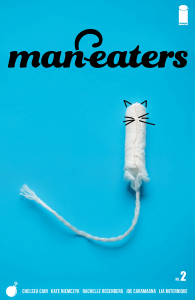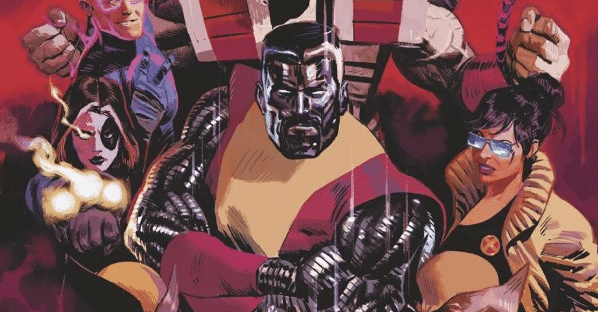 Man-Eaters
Man-Eaters
Writer: Chelsea Cain
Artist: Kate Niemczyk
Colorist: Rachelle Rosenberg
Letterer: Joe Caramagna
Cover: Lia Miternique
Publisher: Image Comics
Two issues into Image Comics’ Man-Eaters, it’s clear why the creative team named their production company the Ministry of Trouble, though it’s less clear whether this book will manage to get out of its own way.
Man-Eaters #1 introduced us to a world where menstruating people can, and most likely will, turn into ferocious, man-eating cats, so to contain the spread of Toxoplasmosis X — a mutation of Toxoplasmosis, a real parasite often found in cat feces and undercooked meat — government agencies have started injecting estrogen and progesterone into the water supply. This, too, has real life precedence: fluoride has been added to community water supplies since the mid-1940s in order to help prevent tooth decay. Like fluoridation of water, adding hormones to the water in Man-Eaters also prompts a lot of pushback — especially since, contrary to the assurance that it will prevent people who menstruate from, you know, menstruating, it doesn’t actually work.
As main character Maude explains at the end of issue #1, “Sometimes one of us slips through [the cracks].”
In issue #2, she attempts to grapple with what that means for her, while her parents — a cop and a big cat veterinarian — investigate the second big cat mauling to occur in just a few days’ time. Ever since hormones were added to the water, attacks have decreased in frequency. However, Maude’s mother gives the reader some brief insight into what will happen if there’s a new uptick in big cat activity: mandatory testing of anyone who could be infected with Toxoplasmosis X (which, according to a flyer at the beginning of the issue, is 98 percent of adolescent AFAB people) and detention centers.
But then, when this attack and another don’t fit the pattern of previous attacks in key ways, a new mystery is borne, which will surely carry through the next several issues.
Man-Eaters has a lot of potential. Kate Niemczyk’s art is clean and Rachelle Rosenberg’s colors are beautiful and cohesive. The art makes the photographic panels that appear on some pages seem especially jarring, which contributes to the overall feeling that shit is about to hit the fan at any given minute. Likewise, Joe Caramagna’s lettering is impeccable, well-placed and easy to follow.
Unfortunately, the story itself, written by Chelsea Cain, leaves much to be desired. On the one hand, she and the Ministry of Trouble have created a compelling story in the same vein as Kelly Sue DeConnick and Valentine De Landro’s Bitch Planet (which gets a nod in Man-Eaters #2 in the form of a poster on a young person’s wall) or Sean Lewis and Caitlin Yarsky’s Coyotes. Casting women as monsters gets at the core of why men in power are so afraid of us, especially when we are young and angry and unafraid. Man-Eaters pushes buttons, but it also gets in its own way, which prevents the story from being truly as radical as it would seem that this creative team wants it to be.
The biggest problem with Man-Eaters is that its story falls along binary gender lines as defined at birth. Attributing menstruation solely to cisgender girls without acknowledging that some trans men, non-binary, gender-nonconforming and agender people also menstruate is frankly irresponsible, especially at a time when the U.S. government is actively attempting to strip away all civil rights protections for trans people.
Plus, main character Maude is a young, white girl; in fact, many of menstruating people we meet in the first two issues — whether they become cats or not — are white or white-passing. Combined with the blatant erasure of trans people, this paints a distinctly White Feminist world that feels out-of-touch with the social commentary Man-Eaters is trying to achieve. Where is the representation for significantly more marginalized groups, including people of color, trans people, people with disabilities (mental or physical), and anyone who lives at any of those intersections?
When issue #1 was released in September, several people including comics creator Alex de Campi called out the trans erasure in Man-Eaters on Twitter. de Campi wrote, “There’s a lot of chat about Maneaters [sic] and its trans exclusion / erasure, and as always it’s trans folk bearing the burden of educating the cis. IMO: This book would have been a LOT more rich and interesting if it had included trans teens in its concept.”
Meanwhile, when Cain was asked about the cis-normative framework in which Man-Eaters is written during an interview with Women Write About Comics, she said, “I think it’s really important to tell stories from a lot of different points of view. This is a story about what it’s like to be a cis gendered female coming of age in a culture that consistently reinforces the messaging that periods are shameful, that our bodies are shameful, and that womanhood — and the biology that goes along with it — is something gross and not for polite company. It’s about rejecting that narrative and making something powerful from it. You don’t have to have a uterus to be a woman. Anyone who thinks that hasn’t been paying attention. But let’s not get lost or distracted here — this is a specific story, about a specific experience — the way that all good stories are. And if I’m doing my job well, I think that anyone can relate to it. I think that someone who is trans knows full well what it feels like to struggle with being defined by biology and by the social messaging that makes us all, at one point or another, feel like monsters.”
Unfortunately, while Cain does acknowledge that trans people exist in this answer, she also refers to womanhood as biologically determined and steps around the issue of not including trans characters in her narrative. It’s not a particularly good look. So it’s not that surprising that two issues in, Man-Eaters is yet to carry its weight as the radical, feminist comic it purports itself to be, which is a shame.



 Man-Eaters
Man-Eaters




Cats spend half their energy pondering how to best keep from infecting us with the parasite they know they have, the reason they cover their poop. Freerange thought.
I am really loving this comic. Glad Marvel can’t cancel her from this.
Comments are closed.